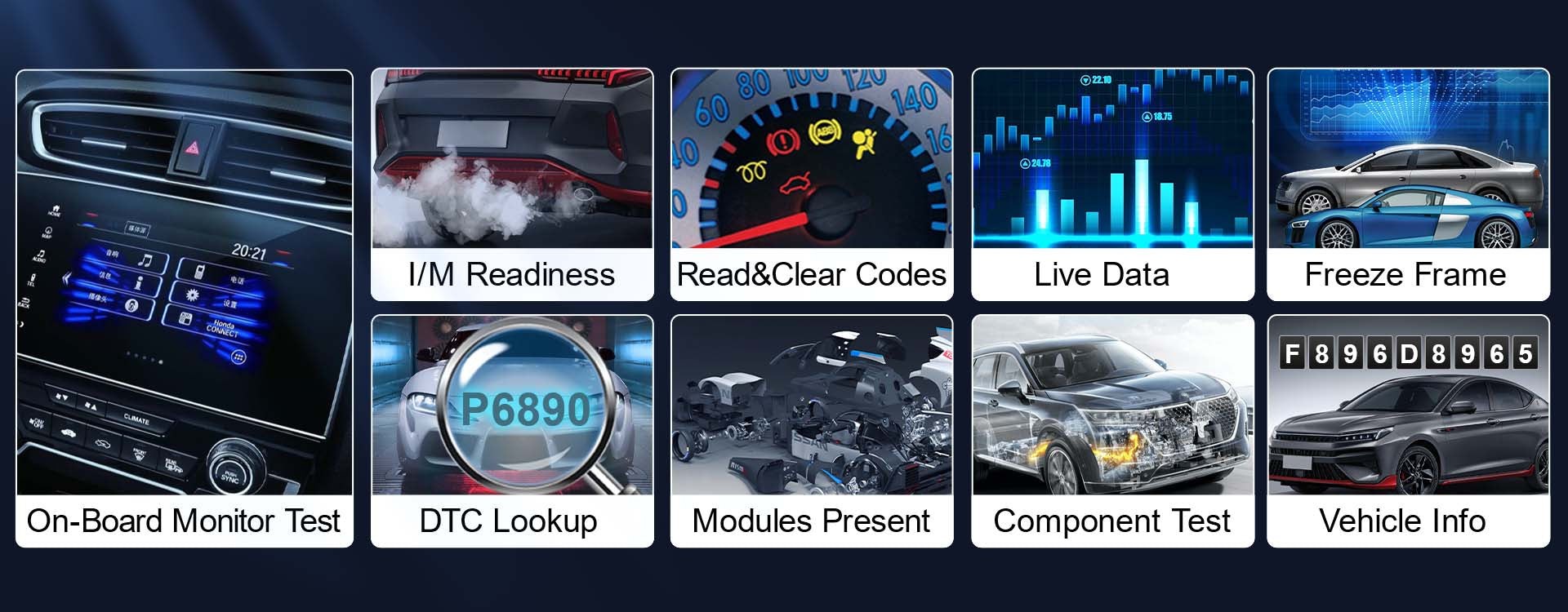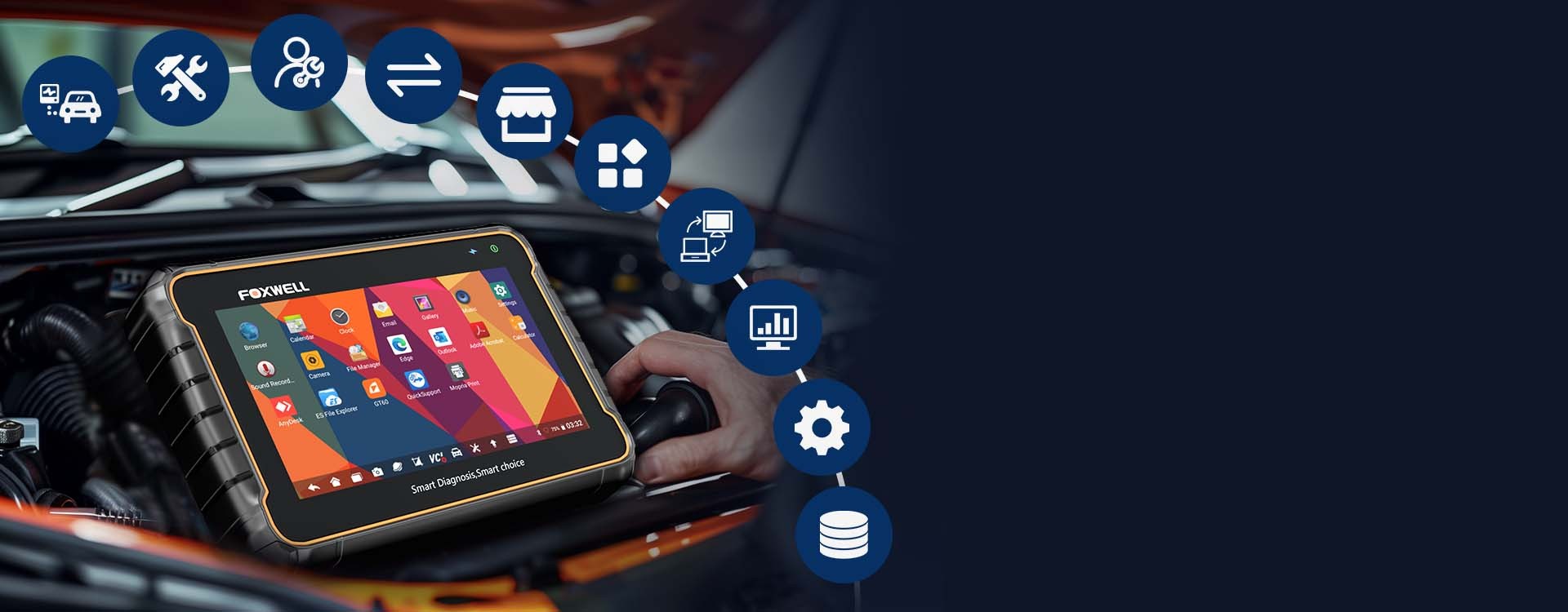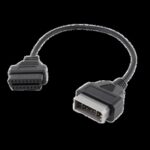The dreaded ABS light on your dashboard – it’s enough to make any driver’s heart sink. Your Anti-lock Braking System (ABS) is crucial for safety, and when that warning light comes on, it signals a potential problem. OBD2 scanners are often touted as handy tools for car diagnostics, but can they really tackle ABS issues? Specifically, can an Obd2 And Abs Scanner reset those worrying ABS codes?
This guide, brought to you by the automotive experts at carparteu.com, will clear up the confusion. We’ll dive deep into whether your OBD2 scanner can effectively reset ABS codes, how to use it, and what to consider to ensure your braking system is functioning perfectly. Whether you’re a seasoned DIY mechanic or just looking to save on repair costs, this information is essential for understanding your vehicle’s health.
Decoding OBD2 Scanners: Beyond the Check Engine Light
An OBD2 scanner is essentially your car’s translator. Modern vehicles are equipped with sophisticated computer systems, and when something malfunctions, these systems generate diagnostic trouble codes. An OBD2 scanner plugs into your car’s diagnostic port, typically located under the dashboard, and retrieves these codes, giving you insight into potential problems.
Most standard OBD2 scanners offer a range of helpful functions:
Reading and Clearing Diagnostic Trouble Codes (DTCs): The most common function is reading and clearing basic DTCs, particularly those related to the engine and transmission. Think of the “Check Engine” light – often triggered by emissions issues, engine misfires, or sensor problems. These scanners excel at identifying and clearing these generic codes.
Real-Time Data Monitoring: OBD2 scanners can display live data from your vehicle’s sensors. This includes vital information like engine temperature, oxygen sensor readings, RPM, and fuel efficiency. It’s like having a live feed of your car’s vital signs as you drive, invaluable for diagnosing intermittent issues.
Emissions Readiness Testing: Before your vehicle undergoes an emissions test, an OBD2 scanner can check its readiness status. This ensures all necessary emission system checks are complete and that your car is likely to pass, saving you potential headaches at the testing center.
ABS Codes: A Different Ballgame from Generic OBD2 Codes
While standard OBD2 scanners are excellent for general engine and transmission diagnostics, ABS codes operate in a more specialized realm. Understanding the difference is crucial when dealing with your brake system.
Let’s consider a scenario: your “Check Engine” light illuminates, and your OBD2 scanner retrieves code P0300, indicating a random engine misfire. Standard OBD2 scanners are designed to easily recognize and interpret these “P-codes” (Powertrain codes).
Now, imagine your ABS light is on instead. Using a more advanced scanner, like a dedicated OBD2 and ABS scanner, such as the Foxwell NT809, you might encounter a code like C0035. This code points to a problem with the left front wheel speed sensor. The key difference? C0035 is an ABS-specific code (“C-code” for Chassis), whereas P0300 is a generic powertrain code.
Here’s a breakdown of why ABS codes are distinct:
System Focus: Generic OBD2 codes primarily address issues within the engine and transmission – the systems responsible for propelling the vehicle. ABS codes, conversely, are dedicated to the braking system and its safety-critical components.
Specificity and Complexity: ABS codes tend to be more detailed and complex. For example, C0110 could indicate a malfunction within the ABS pump motor circuit – an issue completely separate from the engine management system and likely undetectable by a basic OBD2 scanner.
Manufacturer Variations: Unlike standardized generic codes, ABS codes can exhibit manufacturer-specific variations. Code C1235, for instance, might have different meanings for a Ford versus a Toyota. This manufacturer-specific language is a primary reason why not all OBD2 scanners can effectively read or reset ABS codes – they lack the necessary programming to interpret these specialized codes.
Recognizing these distinctions underscores the need for a specialized OBD2 and ABS scanner to properly address ABS-related problems. A generic scanner simply won’t cut it when it comes to diagnosing and resolving issues within your anti-lock braking system.
Identifying the Right OBD2 Scanner for ABS Codes
So, can an OBD2 scanner reset ABS codes? The answer is a qualified yes. It depends entirely on the type of scanner you’re using. Here’s what to look for when seeking a scanner capable of handling ABS:
-
Explicit ABS Compatibility: The scanner must explicitly state ABS system compatibility in its features. Not all OBD2 scanners are created equal; only advanced models are designed to communicate with and diagnose ABS systems. Look for scanners marketed as “full-system diagnostic scanners” or those specifically mentioning ABS support.
-
Enhanced Diagnostic Capabilities: Beyond just ABS, some advanced scanners offer even broader diagnostic coverage, including systems like airbags (SRS), Electronic Stability Control (ESC), and more. These enhanced capabilities provide a more comprehensive picture of your vehicle’s overall health.
-
Vehicle-Specific Software & Updates: Given the manufacturer-specific nature of ABS codes, scanners with vehicle-specific software or update options are highly advantageous. These updates ensure the scanner can accurately interpret the ABS codes for a wider range of makes and models, making them a more versatile tool.
Step-by-Step Guide: Resetting ABS Codes with an OBD2 Scanner
Let’s assume you’ve invested in a capable OBD2 and ABS scanner, such as the Foxwell NT809 or a similar advanced model. Here’s a step-by-step guide on how to use it to reset ABS codes:
-
Connect the Scanner: Locate your vehicle’s OBD2 port. It’s usually found under the dashboard on the driver’s side, near the steering column. Plug your OBD2 and ABS scanner firmly into this port.
-
Power On: Turn your car’s ignition to the “ON” position, but don’t start the engine. This powers up the car’s electrical systems and allows the scanner to communicate with the vehicle’s computer.
-
Vehicle Selection: Using your scanner’s interface, navigate to the vehicle selection menu. Choose your car’s make, model, and year. This step is crucial for the scanner to correctly interpret the data from your specific vehicle’s ABS system.
-
Access the ABS System: Within the scanner’s diagnostic menus, look for an option to access the ABS system, often labeled as “ABS,” “Brake System,” or “Chassis.” Selecting this option directs the scanner to communicate specifically with the ABS control module.
-
Read ABS Codes: Once you’ve accessed the ABS system, instruct the scanner to read codes. The scanner will display any stored ABS trouble codes. Note down these codes for reference. Common ABS codes might include C0035 (wheel speed sensor issue) or C0110 (ABS pump motor problem).
-
Address the Underlying Issue: Crucially, resetting the code is not a fix. You must first diagnose and repair the underlying problem causing the ABS code. For example, if the code indicates a faulty wheel speed sensor, you’ll need to replace the sensor.
-
Clear the Codes: After addressing the issue, use the scanner’s menu option to “Clear Codes” or “Erase Codes” within the ABS system. This action instructs the ABS control module to clear the stored trouble codes and turn off the ABS warning light on your dashboard.
-
Verify and Test: Turn off the ignition, then restart your car and check if the ABS light remains off. Take your vehicle for a short, careful test drive to ensure the ABS system is functioning correctly and the light doesn’t reappear. If the light comes back on, it indicates a persistent issue requiring further diagnosis.
OBD2 Scanners vs. Professional Diagnostic Tools: Choosing the Right Tool
When dealing with ABS codes, you might wonder about the difference between an OBD2 and ABS scanner and the professional-grade diagnostic tools used by mechanics. Here’s a comparison:
| Feature | Advanced OBD2 Scanners | Professional Diagnostic Tools |
|---|---|---|
| Functionality | Reset ABS, SRS, and other specialized codes | Deeper diagnostics, module coding, advanced system tests |
| Ease of Use | User-friendly, designed for DIYers | Requires expertise and training |
| Vehicle Compatibility | Wide range of vehicles | Extensive vehicle support, including specialized systems |
| Data Accuracy | Accurate for most DIY tasks, including ABS codes | Highly accurate, designed for complex and critical issues |
| Price | Affordable, excellent value for advanced features | Expensive, typically for professional workshops |


For most car owners and DIY enthusiasts, an advanced OBD2 and ABS scanner provides a powerful and cost-effective solution for diagnosing and resetting ABS codes and many other vehicle issues. Professional tools offer greater depth and capabilities but come with a significantly higher price tag and learning curve.
When ABS Codes Won’t Clear: Troubleshooting Tips
Occasionally, you might encounter a situation where your OBD2 and ABS scanner refuses to clear the ABS codes. Here’s what could be happening and how to troubleshoot:
Scanner Incompatibility: Double-check your scanner’s specifications to ensure it’s truly compatible with your vehicle’s ABS system. Consult the scanner’s manual or the manufacturer’s website for compatibility information.
Persistent Underlying Issue: The most common reason for codes not clearing is that the underlying problem is still present. A faulty sensor, wiring issue, or hydraulic problem will prevent the ABS system from functioning correctly and will cause the code to reappear immediately after clearing. Thoroughly diagnose and repair the root cause.
Specialized Reset Procedures: Some vehicle manufacturers require specific procedures to clear ABS codes that go beyond a simple “clear codes” command. Consult your vehicle’s repair manual or online resources specific to your make and model for any manufacturer-specific reset procedures.
Professional Assistance: If you’ve exhausted troubleshooting steps and the ABS codes persist, it’s time to seek professional help from a qualified mechanic. They possess advanced diagnostic tools and expertise to pinpoint complex ABS issues and ensure your braking system is safe and functional.
Conclusion: Empowering Yourself with the Right Tools
OBD2 and ABS scanners are invaluable tools for modern car owners. While basic OBD2 scanners are limited in their capabilities, advanced models provide the power to diagnose and reset ABS codes, empowering you to take control of your vehicle maintenance.
However, it’s crucial to remember that resetting codes is only part of the process. Understanding the underlying issues, performing proper repairs, and using the right tools, like a dedicated OBD2 and ABS scanner, are essential for ensuring your vehicle’s safety and longevity. Invest in the right equipment, educate yourself about your car’s systems, and you’ll be well-equipped to handle many common automotive challenges.
FAQs
Can an OBD2 scanner clear the ABS light?
Yes, but only an OBD2 and ABS scanner specifically designed for ABS systems. Basic OBD2 scanners typically lack the functionality to communicate with the ABS control module.
How do I clear my ABS code?
Use an ABS-compatible OBD2 scanner. Connect it to your OBD2 port, access the ABS system menu, read the codes, address the underlying issue, and then use the scanner’s function to clear the codes.
Can you clear fault codes with OBD2?
Yes, OBD2 scanners can clear fault codes. Basic scanners handle engine and transmission codes, while advanced OBD2 and ABS scanners are needed for ABS, SRS, and other specialized systems.
Disclaimer: This article is for informational purposes only and should not be considered professional automotive advice. Always consult with a qualified mechanic for diagnosis and repairs.
